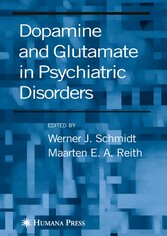Search and Find
Service
"IX NEURODEGENERATION (p. 414-416)
18 Dopamine and Neurodegeneration
Gabriele Gille and Peter Riederer
1. INTRODUCTION
Dopamine (DA) is the prevalent catecholaminergic neurotransmitter in the brain and dopaminergic neurons are mainly located in the substantia nigra (SN), the ventral tegmental area (VTA), and arcuate nuclei. They constitute at least three important dopaminergic pathways: the nigro–striatal, the mesocortical–mesolimbic, and the tubero–infundibular system, which are responsible for locomotor movement, motivation and reward, and secretion of pituitary gland hormones, respectively (1,2).
The dysfunction of these systems can lead to neurological, psychological and endocrinological diseases like, e.g., Parkinson’s disease (PD), attention deficit hyperactivity disorder (ADHD), and prolactinoma (3). There is increasing evidence that DA, besides acting as a neurotransmitter, can become neurotoxic at high concentrations or in an oxidative environment. Especially in idiopathic PD, even though the SN is not the only affected region in the brain, the main pathological hallmark is the progressive degeneration of the neuromelanin-containing dopaminergic neurons in the SN pars compacta (SNpc) causing the cardinal symptoms of tremor, rigidity, and bradykinesia. It is believed that the interplay between the high DA content and a local pro-oxidative environment in the SN mutually promote the increase of oxidative stress and thus the degeneration of dopaminergic neurons.
Principally, DA can exert its neurotoxic effects via oxidative and nonoxidative mechanisms: enzymatic and nonenzymatic oxidation of DA yield redox-active compounds like reactive oxygen species (ROS) and DA-quinones/semiquinones. Condensation reactions of DA with carbonyl groups of aldehydes and α-ketoacids generate tetrahydroisoquinolines (TIQs), which are converted into toxic cations by N-methylation. Moreover, DA can be neurotoxic per se without involving oxidative stress. Possible mechanisms of neurotoxicity and molecular events underlying cell death induced by DA will be discussed in this chapter.
2. OXIDATION REACTIONS OF DA
In the striatum the average DA concentration amounts to 65 μM and in dopaminergic nerve endings a concentration as high as 50 μM is reached, even though most of the DA will be stored in synaptic vesicles (4). When pathological conditions lead to an elevated tunover or release of DA from the vesicles, but also during normal aging, DA-driven production of ROS (H2O2, O2 •−, •OH) and toxic quinone species are accumulated and finally may account for neurodegeneration of the dopaminergic system."
All prices incl. VAT













